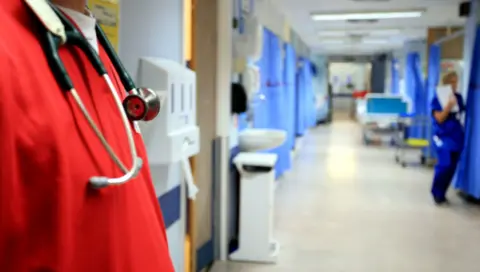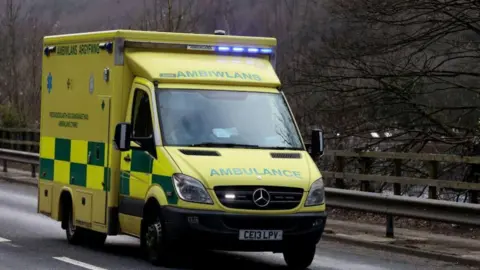NHS waiting lists dip but targets still missed
 BBC
BBCThe number of patients in Wales on a waiting list has dropped by almost 2,000, according to latest figures.
There were 800,395 on what are known as patient pathways in December, down from 802,268 a month earlier.
However, the number of patients waiting more than 36 weeks has hit a record high - at 284,586.
The Welsh government target is no patients should be waiting that long.
Another target to eradicate the longest waits of more than two years has still not been hit, despite being set in March 2023.
However, the number of those waiting longer than two years has fallen by 3% - from 24,361 to 23,621 people.
'Work to do'
Responding to the latest waiting list figures, Health Minister Jeremy Miles said he was pleased with progress on the overall waiting lists and the fall in the number of those waiting longest.
However, he added: "There is still a long way to go and a lot of work to do.
"But this set of data shows the NHS plans to increase capacity and work to reduce the longest waiting times are starting to have an impact."
Miles said the NHS and local authorities "must work together to improve patient flow through the health and care system".
Responding, the Welsh Conservative's health spokesman James Evans said: "These latest statistics represent almost no progress being made by the Welsh Labour government and are by no means good news for patients.
"At this rate, the first minister is set to miss her own self-imposed target to eliminate the very longest waits for the third year in a row."
For Plaid Cymru, Mabon ap Gwynfor said the latest numbers "may seem positive, but it has taken far too long".
He added: "We have seen signs of waiting lists coming down previously, only for Labour to preside over months of lengthening waits."
Cancer care
Overall, of those on patient pathways - which account for patients who may be on multiple waiting lists - it is estimated 616,547 of those patients are waiting for treatment.
In addition to waiting lists, the latest figures on cancer care have also been published, showing the best performance since August 2021.
They show 61.9% of patients started treatment within 62 days in December - an improvement of nearly 5 percentage points on the same time last year.
However, it is still short of the Welsh government target that 75% of patients should begin treatment within that time.
There was also an improvement in waiting times at accident and emergency departments in Wales, with a drop in the number of those attending A&E - with 85,133 patients arriving in January, down more than 2,000 patients since December.
It saw the number of those in A&E being seen within four hours rising to 67.6%. The goal is 95%.
Slightly fewer patients were stuck in the emergency departments for more than 12 hours - down 4% to 10,387. The target is zero.
Dr Rob Perry, Wales' vice-president for the Royal College of Emergency Medicine, said the number of people waiting over 12 hours to be seen was "symptomatic of a whole system which is not functioning as it should".
He added: "When we can't move patients to wards, they end up stranded, often for hours on trolleys in corridors, waiting for a bed to become available.
"These long waits are not just inconvenient; they are degrading and dehumanising."
 Getty Images
Getty ImagesAmbulance crews remain under intense pressure with almost 34,000 999 calls in January.
That is a decrease of 4,300 calls from the previous figures.
It led to more of the most serious 999 calls being answered within the target of eight minutes - at 48.3%. However, that is still far short of the goal of 65%.
Figures from the Welsh Ambulance Trust also show just over 27,000 hours were lost by ambulance crews in handover delays - four times as many hours lost in the latest 12 months compared with 2017.
